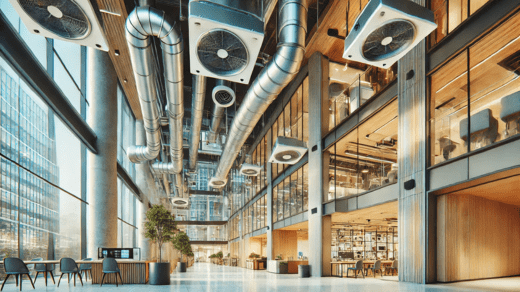Natural Ventilation Systems for Commercial Properties
In the realm of commercial properties, the integration of natural ventilation systems stands out as a proven method to enhance indoor air quality effortlessly. By leveraging the principles of passive airflow and strategically placed vents, these systems enable a continuous exchange of stale indoor air with fresh outdoor air. This not only creates a more pleasant and healthful environment for occupants but also helps in reducing the reliance on mechanical ventilation systems, which can contribute to long-term cost savings and decreased energy consumption.Moreover, the deployment of natural ventilation systems in commercial properties can play a vital role in addressing the pressing concern of carbon footprint reduction. By minimizing the need for energy-intensive HVAC systems to regulate indoor temperatures, these solutions align with sustainability efforts and environmental regulations. As businesses increasingly strive to demonstrate their commitment to eco-conscious practices, integrating natural ventilation systems becomes a tangible way to contribute to a greener and more sustainable future.
Commercial Ventilation systems in commercial properties offer a seamless way to enhance indoor air quality through passive airflow and strategically placed vents. These systems promote a healthier environment, reduce reliance on mechanical ventilation, lower costs, and contribute to sustainability efforts for a greener future.
Benefits of Implementing Natural Ventilation Systems
Natural ventilation systems offer a myriad of advantages for commercial properties. They provide a constant flow of fresh air, reducing the likelihood of stagnant air and helping to maintain a comfortable indoor environment for occupants. By harnessing natural airflow, these systems can also contribute to lower energy consumption, resulting in decreased utility costs for building owners and tenants alike.Moreover, the implementation of natural ventilation systems can boost overall occupant well-being. Improved air quality can lead to enhanced productivity and reduced instances of illness among employees. With better ventilation, indoor spaces become more inviting and conducive to focus, ultimately fostering a healthier and more pleasant working environment.
Improving Indoor Air Quality with Natural Ventilation
Natural ventilation systems play a vital role in enhancing indoor air quality within commercial properties. By allowing for the circulation of fresh outdoor air while expelling stagnant air, these systems help reduce the buildup of pollutants and allergens indoors. This, in turn, creates a healthier and more comfortable environment for occupants, leading to increased productivity and overall well-being.Moreover, natural ventilation systems contribute to minimizing the presence of airborne pathogens and contaminants, thereby reducing the risk of respiratory issues and other health concerns among building occupants. By promoting better air quality through the natural flow of fresh air, these systems can help create a more invigorating and pleasant indoor environment that supports the health and safety of employees and visitors alike.
Energy Efficiency in Commercial Buildings through Natural Ventilation
Natural ventilation systems play a crucial role in enhancing the energy efficiency of commercial buildings. By utilizing strategic designs that leverage natural airflow and ventilation mechanisms, businesses can reduce their reliance on mechanical cooling systems and lower overall energy consumption. This results in cost savings on electricity bills and a decreased carbon footprint, aligning with sustainable practices that benefit both the environment and the bottom line.Moreover, the implementation of natural ventilation systems contributes to a more comfortable indoor environment for building occupants. By promoting better air circulation and fresher air quality, employees and customers alike can enjoy a healthier and more productive space. This improved indoor environment not only enhances the overall well-being of individuals but also leads to increased focus and efficiency, ultimately driving business success.
Enhancing Employee Health and Productivity with Natural Ventilation Systems
Natural ventilation systems play a crucial role in creating a healthier and more productive work environment for employees in commercial properties. By allowing fresh air to circulate freely, these systems help in reducing indoor air pollutants, which can lead to respiratory issues and decreased cognitive function. Poor indoor air quality has been linked to symptoms such as headaches, fatigue, and allergies, affecting employee well-being and overall performance.Moreover, natural ventilation systems contribute to maintaining optimal temperature and humidity levels within the workspace. By regulating these environmental factors, employees are able to work comfortably, leading to enhanced focus and productivity. A well-ventilated workplace not only enhances the physical health of employees but also fosters a more positive and energized atmosphere, ultimately boosting morale and job satisfaction.
Natural Home Solutions offer natural ventilation systems that enhance employee health and productivity in commercial properties. These systems reduce indoor air pollutants, improve temperature and humidity levels, and create a positive work atmosphere, resulting in increased focus, morale, and job satisfaction.
Cost Savings Associated with Natural Ventilation in Commercial Properties
Natural ventilation systems in commercial properties can lead to significant cost savings over time. By harnessing natural airflow through strategic building design and ventilation solutions, businesses can reduce their reliance on mechanical cooling and ventilation systems, ultimately lowering energy consumption and operational costs. This not only translates into immediate financial benefits but also contributes to long-term sustainability by decreasing the overall carbon footprint of the property.Moreover, the cost savings associated with natural ventilation extend beyond reduced energy expenses. With improved indoor air quality and circulation provided by these systems, businesses can potentially see a decrease in employee absenteeism and health-related issues. By fostering a healthier and more comfortable working environment, companies may experience increased employee productivity and satisfaction, further enhancing the cost-effectiveness of implementing natural ventilation solutions in commercial properties.
Regulatory Compliance and Natural Ventilation Systems
When it comes to regulatory compliance in commercial properties, the integration of natural ventilation systems plays a crucial role. Building codes and regulations often require a certain level of indoor air quality and ventilation to ensure the health and safety of occupants. By implementing natural ventilation systems, property owners can align with these standards while providing a sustainable and efficient solution for air circulation within the building.Natural ventilation systems not only help commercial properties adhere to regulatory requirements but also offer a cost-effective and environmentally friendly approach to indoor air quality management. By harnessing natural airflow and sunlight, these systems reduce the dependency on mechanical ventilation systems, thereby decreasing energy consumption and lowering operational costs. Furthermore, by promoting the use of natural elements for ventilation, businesses can demonstrate their commitment to reducing their carbon footprint and contributing to a more sustainable future.
Reducing Carbon Footprint with Natural Ventilation Systems
Implementing natural ventilation systems in commercial properties is a strategic approach to reducing the carbon footprint associated with traditional HVAC systems. By harnessing the power of natural airflow and passive cooling techniques, businesses can significantly decrease their reliance on energy-intensive heating and cooling systems that contribute to greenhouse gas emissions. Through thoughtful design and placement of ventilation components such as operable windows, louvers, and rooftop vents, commercial buildings can effectively regulate indoor temperatures while minimizing the environmental impact.The adoption of natural ventilation systems not only offers a sustainable solution for reducing carbon emissions but also aligns with corporate social responsibility goals. By prioritizing eco-friendly practices like utilizing natural airflow for cooling and ventilation, businesses can demonstrate their commitment to environmental stewardship and sustainability. Beyond the tangible benefits of energy savings and reduced operational costs, investing in natural ventilation systems presents a tangible opportunity for commercial properties to make a positive impact on the environment and contribute to a greener future.
Design Considerations for Natural Ventilation in Commercial Buildings
When designing natural ventilation systems for commercial buildings, it is crucial to prioritize the building’s layout and orientation to maximize airflow efficiency. Proper positioning of windows, vents, and other openings can facilitate the flow of fresh air throughout the building while also allowing for the expulsion of stale air. Additionally, consideration should be given to the surrounding environment, such as nearby buildings or natural features, to leverage external factors that can enhance the natural ventilation process.Incorporating adjustable elements, such as louvers or dampers, in the design of natural ventilation systems can provide flexibility in controlling airflow based on varying weather conditions and occupant preferences. These adjustable features allow for fine-tuning of ventilation levels to maintain optimal indoor air quality and thermal comfort. Moreover, integrating automated systems that can monitor air quality and adjust ventilation accordingly can further enhance the overall effectiveness and efficiency of natural ventilation in commercial properties.
Case Studies of Successful Implementation of Natural Ventilation Systems in Commercial Properties
Natural Home Solutions recently completed a project at a bustling office complex in the heart of the city. By integrating innovative natural ventilation systems, the company successfully enhanced indoor air quality, resulting in a noticeable improvement in employee well-being and productivity. The combination of strategically positioned windows and skylights not only allowed for better airflow but also significantly reduced the need for mechanical cooling systems, leading to substantial energy savings for the property.In another instance, Natural Home Solutions collaborated with a retail chain to implement natural ventilation solutions across multiple store locations. By introducing operable windows and incorporating passive cooling techniques, the company helped create a more comfortable shopping environment for customers while lowering overall operational costs. The successful integration of these systems not only aligned with the brand’s commitment to sustainability but also showcased the direct impact of natural ventilation on reducing carbon footprint within commercial settings.

